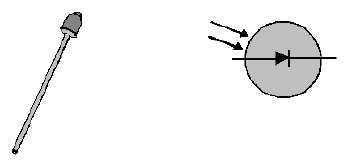3-30
Figure 3-30.—Stacked seven-segment display.
Another special optoelectronic device in common use today is the photodiode. Unlike the LED,
which produces light, the photodiode uses light to accomplish special circuit functions. Basically, the
PHOTODIODE is a light-controlled variable resistor. In total darkness, it has a relatively high resistance
and therefore conducts little current. However, when the PN junction is exposed to an external light
source, internal resistance decreases and current flow increases. The photodiode is operated with
reverse-bias and conducts current in direct proportion to the intensity of the light source.
Figure 3-31 shows a photodiode with its schematic symbol. The arrows pointing toward the symbol
indicate that light is required for operation of the device. A light source is aimed at the photodiode
through a transparent "window" placed over the semiconductor chip. Switching the light source on or off
changes the conduction level of the photodiode. Varying the light intensity controls the amount of
conduction. Because photodiodes respond quickly to changes in light intensity, they are extremely useful
in digital applications such as computer card readers, paper tape readers, and photographic light meters.
They are also used in some types of optical scanning equipment.
Figure 3-31.—Photodiode.
A second optoelectronic device that conducts current when exposed to light is the
PHOTOTRANSISTOR. A phototransistor, however, is much more sensitive to light and produces more
output current for a given light intensity that does a photodiode. Figure 3-32 shows one type of
phototransistor, which is made by placing a photodiode in the base circuit of an NPN transistor. Light
falling on the photodiode changes the base current of the transistor, causing the collector current to be
amplified. Phototransistors may also be of the PNP type, with the photodiode placed in the base-collector
circuit.



